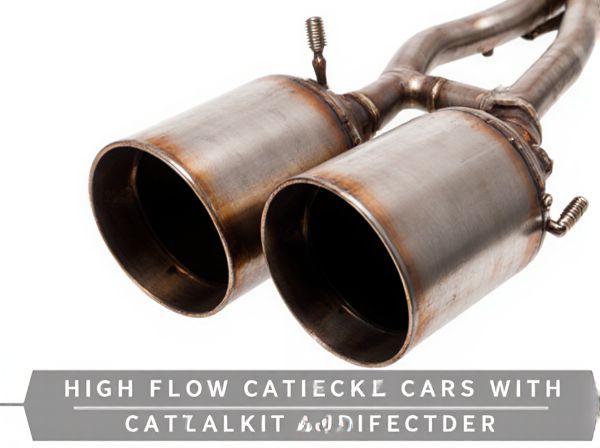
Photo illustration: High-flow Catalytic Converter vs Stock Catalytic Converter
A high-flow catalytic converter enhances exhaust gas flow, improving engine performance and fuel efficiency compared to stock catalytic converters that prioritize emissions reduction over flow. Your vehicle benefits from reduced backpressure and increased horsepower with a high-flow option, making it ideal for performance upgrades. Stock catalytic converters maintain stricter emission standards but may limit power output due to higher flow restrictions.
Table of Comparison
| Feature | High-flow Catalytic Converter | Stock Catalytic Converter |
|---|---|---|
| Performance | Improves exhaust flow, increasing horsepower and torque | Standard flow, optimized for emissions control, limits performance |
| Emission Control | Reduces emissions but slightly less efficient than stock | Meets strict OEM emission standards |
| Material | High-grade stainless steel with ceramic or metallic substrates | OEM-grade stainless steel with ceramic substrates |
| Durability | Long-lasting with corrosion resistance | Designed for long-term OEM specifications |
| Price | Higher initial cost | Lower initial cost |
| Sound | May produce a deeper, more aggressive exhaust note | Quieter, factory-tuned exhaust sound |
| Installation | Direct fit or universal, may require modifications | Direct fit, OEM approved |
Introduction to Catalytic Converters
Catalytic converters are essential automotive components designed to reduce harmful emissions by converting toxic gases like carbon monoxide, hydrocarbons, and nitrogen oxides into less harmful substances such as carbon dioxide, nitrogen, and water vapor. High-flow catalytic converters feature larger or more efficient substrates that allow increased exhaust flow, improving engine performance and fuel efficiency compared to standard stock catalytic converters. While stock converters prioritize emission control to meet regulatory standards, high-flow variants balance emissions reduction with enhanced vehicle power output, making them popular in performance tuning and aftermarket upgrades.
What Is a Stock Catalytic Converter?
A stock catalytic converter is the original emissions control device installed by the vehicle manufacturer, designed to meet strict government regulations for reducing harmful exhaust gases such as carbon monoxide, hydrocarbons, and nitrogen oxides. It features a standardized catalytic substrate and limited flow capacity optimized for longevity and compliance rather than peak performance. Unlike high-flow catalytic converters, stock converters prioritize efficient pollutant conversion over airflow, resulting in higher backpressure but superior environmental protection.
What Is a High-Flow Catalytic Converter?
A high-flow catalytic converter is an advanced emission control device designed to reduce exhaust backpressure while maintaining efficient pollutant reduction, significantly improving engine performance compared to a stock catalytic converter. It utilizes a less restrictive substrate made from materials like ceramic or metallic honeycombs coated with precious metals such as platinum, palladium, and rhodium, enabling faster exhaust gas flow and improved catalytic reactions. This enhancement leads to increased horsepower and torque without compromising emissions compliance, making it a popular upgrade for performance vehicles.
Core Differences: High-Flow vs. Stock Catalytic Converters
High-flow catalytic converters feature larger internal channels and a less dense ceramic core compared to stock catalytic converters, enabling improved exhaust gas flow and increased engine performance. Stock catalytic converters prioritize emissions reduction with a dense substrate coated in precious metals, resulting in higher backpressure and slightly reduced power output. The core difference lies in balancing emission control efficiency against enhanced exhaust flow and horsepower gains.
Performance Impact: Power and Efficiency
High-flow catalytic converters enhance engine performance by reducing exhaust backpressure, allowing for improved horsepower and torque compared to stock catalytic converters. These converters maintain emissions compliance while increasing efficiency, contributing to better fuel economy under certain driving conditions. Conversely, stock catalytic converters prioritize emissions control with higher flow restrictions, which may limit power output but ensure optimal pollutant reduction and long-term durability.
Emissions and Environmental Considerations
High-flow catalytic converters significantly reduce harmful emissions such as carbon monoxide (CO), hydrocarbons (HC), and nitrogen oxides (NOx) by enhancing exhaust flow and improving catalytic efficiency compared to stock catalytic converters. They often feature advanced catalyst coatings and increased surface area, leading to faster light-off temperatures that minimize cold-start emissions, crucial for environmental protection. However, compatibility with emissions regulations and vehicle-specific tuning is essential to ensure these high-flow converters maintain compliance and effectively reduce environmental impact.
Compatibility and Installation Requirements
High-flow catalytic converters offer enhanced exhaust flow and performance but may require specific modifications to fit certain vehicle models, making compatibility a crucial consideration. Stock catalytic converters are designed as direct replacements for factory components, ensuring straightforward installation with factory mounting points and minimal adjustments. Understanding vehicle specifications and exhaust system design is essential for selecting the appropriate catalytic converter to avoid installation issues and maintain emissions compliance.
Longevity and Maintenance Factors
High-flow catalytic converters typically have a more durable ceramic or metallic substrate designed for improved exhaust flow, which can extend longevity compared to standard stock converters that often use denser substrates prone to clogging. Maintenance considerations show high-flow units require periodic inspections to prevent carbon buildup and catalytic poisoning, while stock converters generally demand fewer interventions but are more vulnerable to early failure from thermal stress. Selecting a high-flow converter enhances performance and lifespan if paired with proper maintenance, whereas stock converters may be more cost-effective but less robust over time.
Cost Comparison and Value Analysis
High-flow catalytic converters typically cost between $150 and $400, significantly higher than stock catalytic converters, which range from $50 to $200. The increased price reflects improved exhaust flow, enhanced horsepower gains, and reduced backpressure, making high-flow options ideal for performance vehicles. Value analysis highlights that while stock converters provide effective emissions control at a lower cost, high-flow catalytic converters deliver superior performance benefits, justifying the premium for enthusiasts and professional tuners.
Which Catalytic Converter Is Right for You?
High-flow catalytic converters increase exhaust flow and improve engine performance by reducing backpressure, making them ideal for modified or high-performance vehicles. Stock catalytic converters prioritize emissions compliance and durability, suitable for daily drivers adhering to strict environmental regulations. Choosing the right catalytic converter depends on your vehicle's performance goals, local emissions laws, and intended usage.
 caratoz.com
caratoz.com